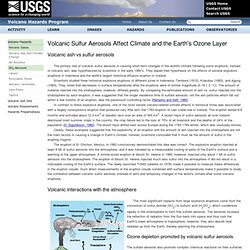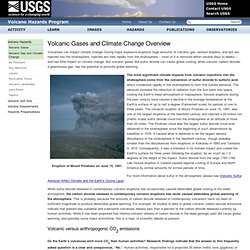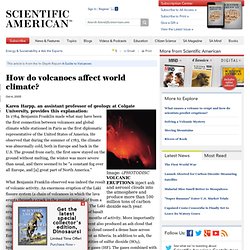

Www.uamont.edu/facultyweb/edson/minerals and lab handouts/Lab worksheet for topo maps - part 1.pdf. World. Volcanic Sulfur Aerosols Affect Climate and the Earth's Ozone Layer. Volcanic ash vs sulfur aerosols The primary role of volcanic sulfur aerosols in causing short-term changes in the world's climate following some eruptions, instead of volcanic ash, was hypothesized by scientists in the early 1980's.

They based their hypothesis on the effects of several explosive eruptions in Indonesia and the world's largest historical effusive eruption in Iceland. Scientists studied three historical explosive eruptions of different sizes in Indonesia--Tambora (1815), Krakatau (1883), and Agung (1963). They noted that decreases in surface temperatures after the eruptions were of similar magnitude (0.18-1.3 °C). The amount of material injected into the stratosphere, however, differed greatly. In contrast to these explosive eruptions, one of the most severe volcano-related climate effects in historical times was associated with a largely nonexplosive eruption that produced very little ash--the 1783 eruption of Laki crater-row in Iceland.
Figure modified by K. References. Volcanic Gases and Climate Change Overview. Volcanoes can impact climate change.

During major explosive eruptions huge amounts of volcanic gas, aerosol droplets, and ash are injected into the stratosphere. Injected ash falls rapidly from the stratosphere -- most of it is removed within several days to weeks -- and has little impact on climate change. But volcanic gases like sulfur dioxide can cause global cooling, while volcanic carbon dioxide, a greenhouse gas, has the potential to promote global warming. Eruption of Mount Pinatubo on June 15, 1991. The most significant climate impacts from volcanic injections into the stratosphere come from the conversion of sulfur dioxide to sulfuric acid, which condenses rapidly in the stratosphere to form fine sulfate aerosols.
For more information about sulfur in the atmosphere, please see Volcanic Sulfur Aerosols Affect Climate and the Earth's Ozone Layer. Volcanic versus anthropogenic CO2 emissions Do the Earth’s volcanoes emit more CO2 than human activities? More information References. How do volcanoes affect world climate? Karen Harpp, an assistant professor of geology at Colgate University, provides this explanation: In 1784, Benjamin Franklin made what may have been the first connection between volcanoes and global climate while stationed in Paris as the first diplomatic representative of the United States of America.

He observed that during the summer of 1783, the climate was abnormally cold, both in Europe and back in the U.S. The ground froze early, the first snow stayed on the ground without melting, the winter was more severe than usual, and there seemed to be "a constant fog over all Europe, and [a] great part of North America.
" What Benjamin Franklin observed was indeed the result of volcanic activity. An enormous eruption of the Laki fissure system (a chain of volcanoes in which the lava erupts through a crack in the ground instead of from a single point) in Iceland caused the disruptions. There are many reasons that large volcanic eruptions have such far-reaching effects on global climate. LIA_lesson8_9.28.05. Mentos Diet Coke Geyser. This activity is probably best done outside in the middle of an abandoned field, or better yet, on a huge lawn.

Carefully open the bottle of soda. Position the bottle on the ground so that it will not tip over. Unwrap the whole roll of Mentos. The goal is to drop all of the Mentos into the bottle of soda at the same time (which is trickier than it looks). One method for doing this is to roll a piece of paper into a tube just big enough to hold the loose Mentos. The Geyser Tube Variation You’ll need a 2-liter bottle of diet soda (diet doesn’t make a sticky mess) and an outdoor location for your geyser. Here's the question of the day... As you probably know, soda pop is basically sugar (or diet sweetener), flavoring, water, and preservatives. But there's more... Water molecules strongly attract each other, linking together to form a tight mesh around each bubble of carbon dioxide gas in the soda. Next question...